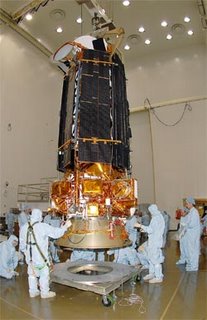 DoD has launched a new DMSP (Defense Meteorological Satellite Program) weather satellite - DMSP 5D-3 F17.
DoD has launched a new DMSP (Defense Meteorological Satellite Program) weather satellite - DMSP 5D-3 F17.Particulars on this satellite and launch:
Intl Designator: 2006-050A
SSC#: 29522
Launch Date: 11/4/2006 at 1353 UTC
Launch Site: SLC6, Western Test Range, Vandenberg AFB, CA
Launch Vehicle: Boeing Delta 4M
Orbital parameters: 850 x 846-km, 98.8 deg inclination
This satellite is in a sun synchronous orbit and will be a morning imaging satellite. It will replace DMSP 5D-2 F13 (USA 109) launched 3/24/1995 at 1405 UTC (1995-015A/23533). That bird will now become the in-orbit backup for F17 once it becomes operational.
The Block 5D-3 series accommodates larger sensor payloads than earlier generations. They also feature a larger capability power subsystem; a more powerful on-board computer with increased memory -- allowing greater spacecraft autonomy -- and increased battery capacity that extends the mean mission duration. Starting with F-17, the attitude control subsystem has also been enhanced with the integration of a second inertial measurement unit using ring laser, versus mechanical, gyros to provide greater precision pointing flexibility.
DMSP is used for strategic and tactical weather prediction to aid the U.S. military in planning operations at sea, on land and in the air. Equipped with a sophisticated sensor suite that can image visible and infrared cloud cover and measure precipitation, surface temperature, and soil moisture, the satellite collects specialized global meteorological, oceanographic, and solar-geophysical information in all weather conditions. The DMSP constellation comprises two spacecraft in near-polar orbits, C3 (command, control and communications), user terminals and weather centers. The most recent launch of a DMSP spacecraft took place on October 18, 2003 from Vandenberg Air Force Base, on the final Titan II booster flown.
Including DMSP F-17, four satellites remain to be launched and are maintained at Space Systems' operations in Sunnyvale, Calif. for storage, functional testing, and upgrading. The spacecraft are shipped to Vandenberg for launch when requested by the Air Force. Since 1965, 43 Lockheed Martin DMSP satellites have been launched successfully by the U.S. Air Force. Now in its fourth decade of service, the DMSP has proven itself to be a valuable tool in scheduling and protecting military operations on land, at sea and in the air. The Space and Missile Systems Center at Los Angeles Air Force Base, Calif. manages the DMSP program. This satellite is operated for DoD by NOAA who is also responsible for the NOAA polar orbiters.
The next Delta launch will be of a GPS navigation satellite aboard a Delta II from Cape Canaveral Air Force Station, Fla., in mid-November.